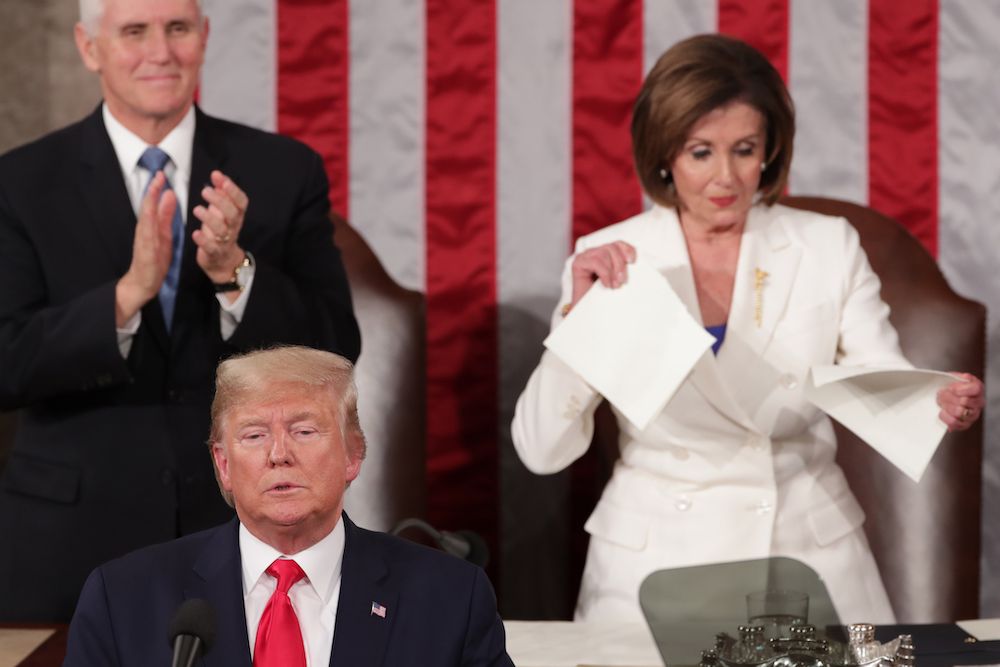President Trump State of the Union address

A few minutes every morning is all you need.
Stay up to date on the world's Headlines and Human Stories. It's fun, it's factual, it's fluff-free.
On Tuesday, February 4, 2020, President Donald Trump gave the annual State of the Union address in front of a joint session of Congress. The televised speech was used to tout the accomplishments of his administration and highlight special guests.
The State of the Union is customarily an opportunity for the president to lay out his agenda for the year. However, this year’s address was given in the shadow of Trump’s impeachment and was met with considerable criticism.
Trump’s State of the Union address
Tuesday night’s State of the Union address was Trump’s third time addressing the joint Congress. It began at 9:03 pm EST when Trump entered the United States Capitol. Shortly thereafter, as is customary, the president was introduced by Speaker of the House Nancy Pelosi before beginning his hour-plus address.
Trump set the tone of the speech early, opening with a rundown of his administration’s accomplishments, which he would discuss in greater detail throughout the address:
“Tonight I stand before you to share the incredible results. Jobs are booming, incomes are soaring, poverty is plummeting, crime is falling, confidence is surging, and our country is thriving and highly respected again. America’s enemies are on the run.”
An NPR fact check of the speech noted that many of Trump’s boasts were half true or outright false. For instance, Trump stated that “jobs are booming”, and while the US economy did add 3.7 million jobs in Trump’s first three years, that’s a drop from President Barack Obama’s last three years when the US added a little more than 8.4 million jobs.
NPR also found that, while Trump was correct to say that the unemployment rate is the lowest it’s been in 50 years, they disputed his claim that America’s economy is “moving forward at a pace that was unimaginable just a short time ago.” In fact, the current 2.3% growth rate is the average over the last 10 years and is markedly lower than the 3% growth Trump promised as a candidate.
The Senate impeachment trial
The political backdrop of this State of the Union address was more volatile than usual. For one, the Democratic primaries began the night before with a calamitous Iowa caucus in which technological mishaps prevented results from being determined. By the time Trump’s speech began, the full results still weren’t known, though the DNC had released results for 62% of the state (by the end of the day, they’d released 71%).
Trump also had his impeachment and possible removal from office to contend with, though he made no mention of it in his State of the Union address. The House managers completed their case against Trump on Friday, January 24, while Trump’s defense team finished their arguments on Tuesday, January 28.
With the Republicans having successfully blocked additional testimony or evidence, Senators voted to acquit Trump on Wednesday, February 5. However, one Republican Senator, Mitt Romney of Utah, voted to convict the president on the charge of abuse of power. Romney is believed to be the first senator in history to vote to convict a member of his own party on the charge of impeachment.
President Bill Clinton, who was acquitted in his Senate impeachment trial in 1998, also gave an State of the Union address in the midst of the trial.
The icy reception to the State of the Union
In a period of record-setting partisan divide, the State of the Union address was bound to be met with criticism and political pushback. Far beyond the usual opposition party response to the president’s address, Trump’s speech was heavily criticized by Democrats.
As CNN anchor Jake Tapper noted on Twitter, Pelosi changed up the traditional presidential introduction. Usually, the Speaker says, “Members of Congress, I have the high privilege and distinct honor of presenting to you the President of the United States.” Instead, Pelosi simply said, “Members of Congress, the President of the United States.”
This introduction came shortly after Trump refused to shake Pelosi’s hand after mounting the dais. Pelosi, for her part, openly tore up Trump’s speech after he’d concluded it.
The acrimonious reception to the address started even before Trump entered the chamber. Eight members of Congress announced prior to the State of the Union address that they would not be in attendance. Another US Representative, Rashida Tlaib, who was in attendance, tweeted that she walked out of the speech, saying it “was all beneath the dignity of the office.”
Notable guests at the State of the Union
Trump continued the tradition of inviting guests and specifically mentioning them in the speech, which started with President Ronald Reagan‘s first State of the Union address in 1982.
Among Trump’s guests were members of the military and civilians, who he highlighted as extraordinary Americans. There were also a few surprises. Conservative talk radio host Rush Limbaugh, who recently announced he had stage 4 lung cancer, was given the Presidential Medal of Freedom during the address.
Also in attendance was Juan Guaido, who the Trump administration recognizes as the legitimate president of Venezuela. In his State of the Union address, Trump called Venezuela’s president Nicolás Maduro “an illegitimate ruler, a tyrant who brutalizes his people.”
The history of the State of the Union address
The annual State of the Union address, which in recent tradition is given in person to Congress, is established in Article II, Section 3, Clause 1 of the US Constitution:
“[The president] shall from time to time give to the Congress Information of the State of the Union, and recommend to their Consideration such Measures as he shall judge necessary and expedient.”
Despite the wording in the Constitution, the annual address wasn’t officially called the State of the Union until 1947. Before that, it was simply known as the “Annual Message”.
Prior to President Woodrow Wilson’s Annual Message in 1913, it was rare for the president to give the address in person. Throughout most of the 20th century and up until today, it has been the norm for the president to give the State of the Union address in person.
The first radio broadcast of an annual message was for President Calvin Coolidge in 1923. In 1947, President Harry Truman was the first to give a televised address, but President Lyndon Johnson’s 1965 address set the standard for giving the speech at night so more people could watch it at home. President George W. Bush’s 2002 speech was the first to be live streamed online.Only two presidents – William Henry Harrison and James A. Garfield (both 19th century presidents) – failed to give an Annual Address/State of the Union.
[article_ad]




Comments ()